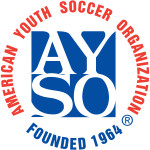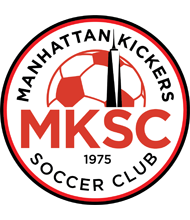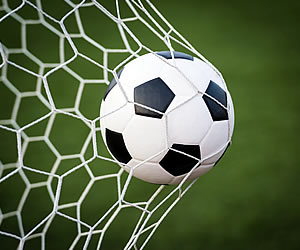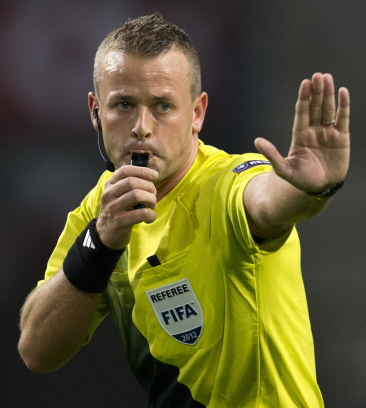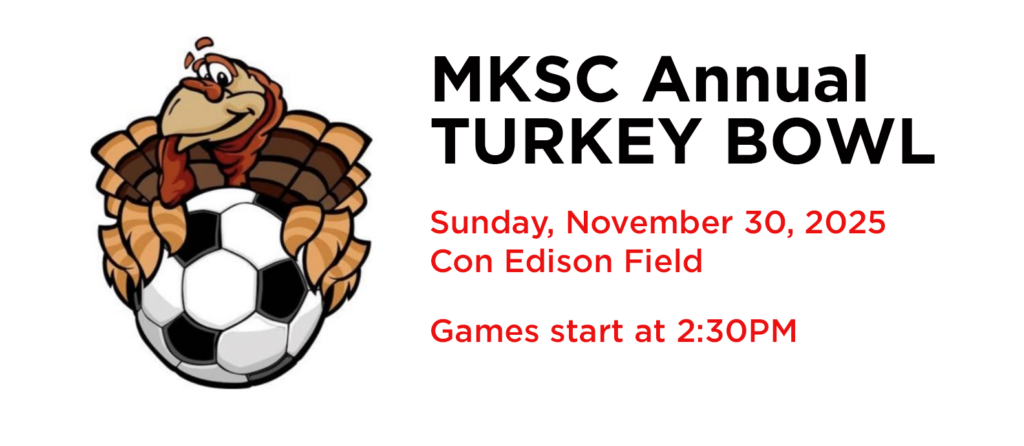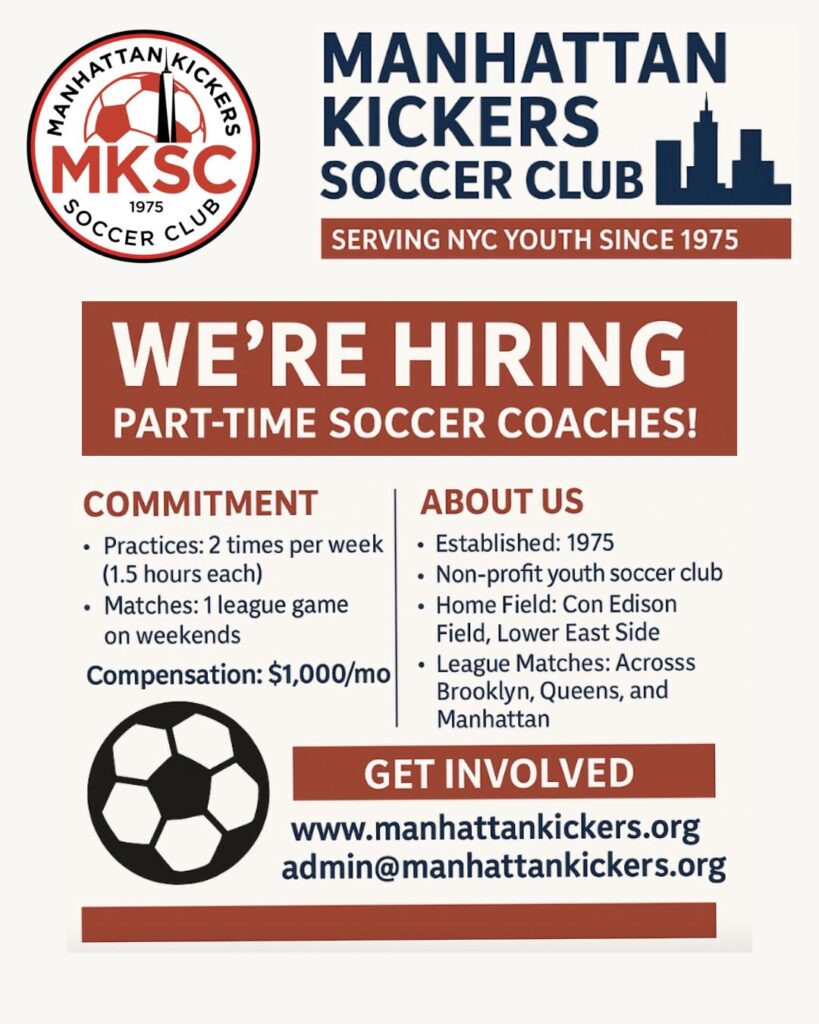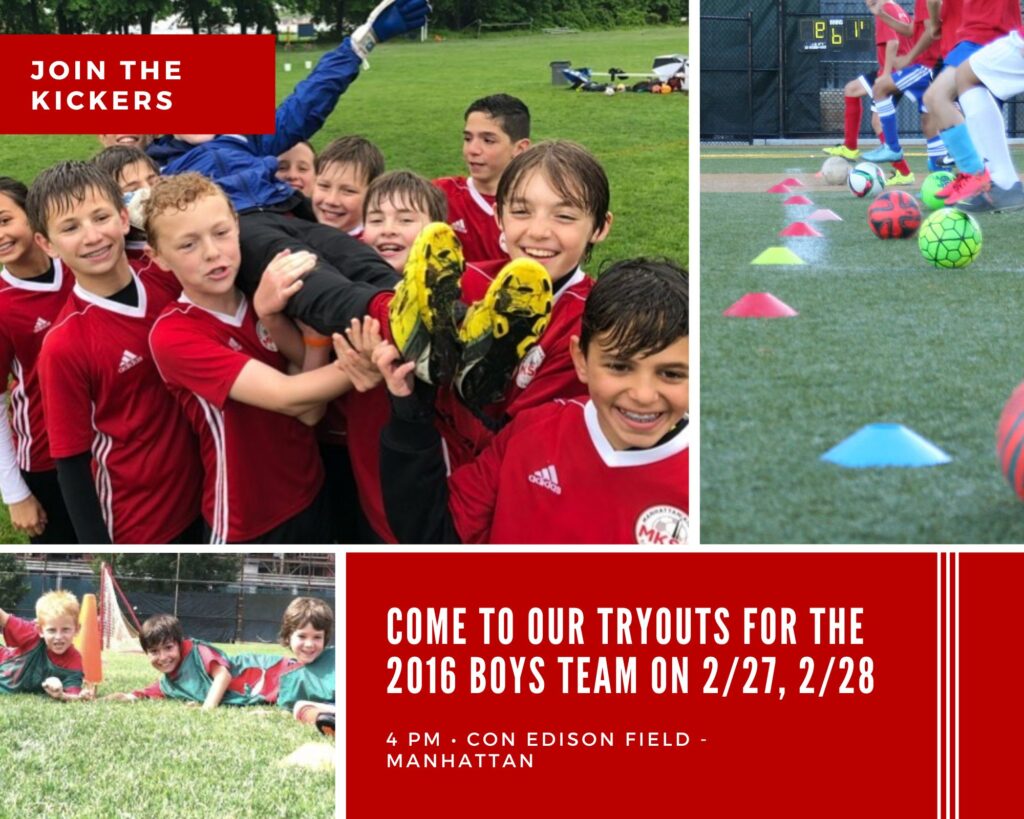Recreational Program General Information
The fields that we play on are at the Con Ed Fields (16th Street and Avenue C) and Murphy's Brother's Playground (17th Street and Avenue C) on Manhattan's East Side. MKSC has made significant financial contributions to support the maintenance of these fields in partnership with Peter Stuyvesant Little League and the NYC Parks Department.

GENERAL FIELD RULES
- No smoking on or near any fields
- No dogs allowed on or near any fields
-
No bicycles or scooters allowed on any fieldsPlease chain them to the nearest fence outside the field
Manhattan Kickers Playoff Rules
-
All regular season rules apply.
- If a playoff game is tied at the end of regulation, there will be overtime.
- The team that did not call the coin flip at the beginning of the game calls to determine kick-off or the side of the field.
- There will be a 2-minute break between the 4th quarter and overtime.
- Overtime is 5 minutes – sudden death.
- If game is still tied after the 1st overtime; no break; teams switch sides; other team kicks, and another 5 minute – sudden death, overtime period is played.
- If game is still tied – there is a shoot out.
- Penalty kick distance – 10 yards.
- Referees choose which goal will be used.
- There is a coin flip to determine who will kick first.
- EVERYBODY, except the referees, goalkeeper, and shooter, will remain behind the midfield line. Failure to comply with this rule will result in the loss of a kick.
- Each coach selects 5 players to take the kicks. Goalkeepers may be one of the five. Disqualified players may not participate in the shootout.
- Teams will alternate kickers.
- The goalkeeper may be changed prior to each shot.
- Whichever team scores more goals is the winner.
- If the game remains after 5 kicks, each coach will select 5 different players. The teams now go shot for shot. (i.e. If one team scores on the 1st extra shot and the other team does not – no more shots are taken – and the first team is declared the winner.)
- One goal is added to the winner’s final score. (i.e. 1-1 prior to shootout; 2-1 final score.)
-
Player may not kick until the referee blows the whistle.
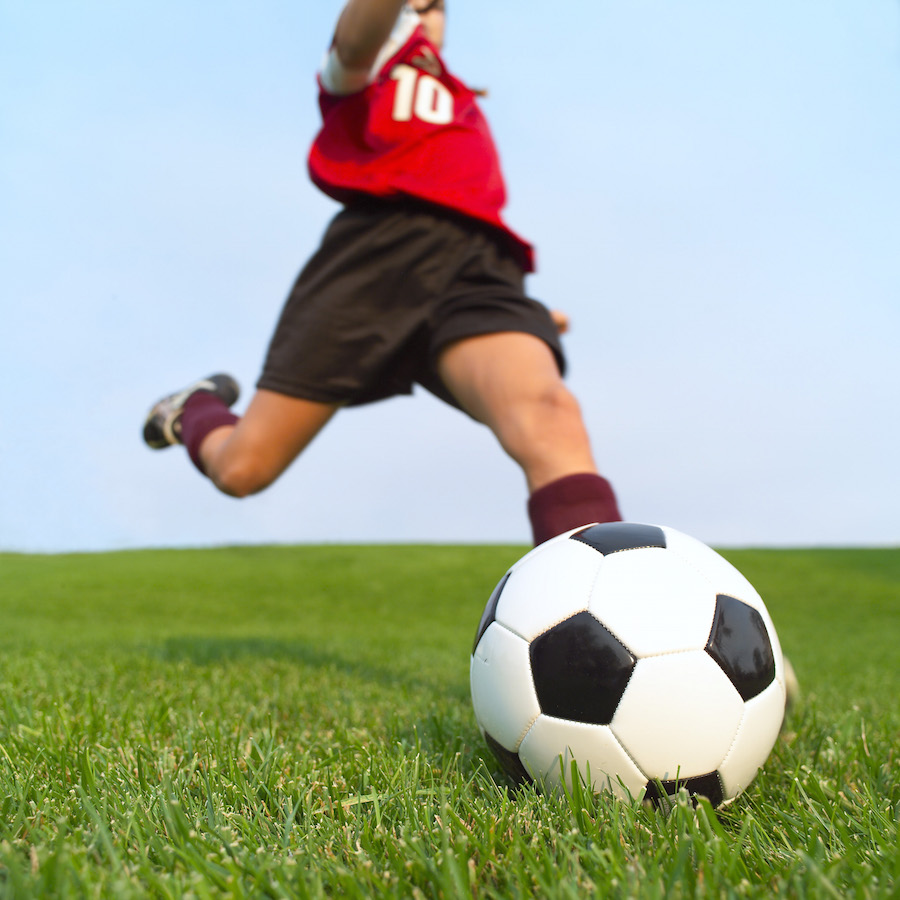
- Any noise, interference, or taunting by fans or opposing team will result in a re-do of the kick.
- Goalie must stand on the goal line and can’t move his/her feet until the ball is kicked.
- Once the kicker moves towards the ball he/she may not move back and then shoot.
- If the goalkeeper catches the ball with his/her feet behind the goal line, it is not a goal unless the entire ball is across the goal line.
- One referee should be standing on the goal line, looking across the goal to see if the ball crosses the line. The other referee should stand even with the penalty kick line.
- In the shootout, once the ball reverses direction, hits the goalkeeper, post, or crossbar, the ball is dead. No goal.
- No follow-up shots are allowed.
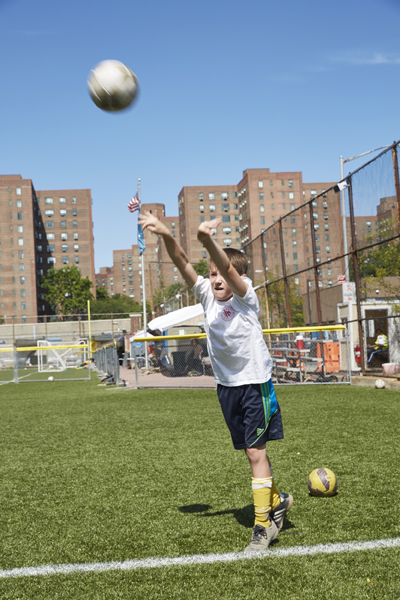 Basic Intramural Soccer Policies
Basic Intramural Soccer Policies
- For everybody’s safety, players must remove any watches or jewelry
- Hats may not be worn
- Shin guards are required gear
- All goal-keepers must wear colors, which distinguish them from the other players and from the referees
- All payers must play a minimum of three quarters of each game; no player is allowed to sit out more than one quarter per game
At the beginning of the game, choice of ends and the kick-off will be decided by the toss of a coin. The game shall be started by a player taking a place-kick (i.e. a kick at the ball while it is stationary on the ground in the center of the field of play) into his opponents’ half of the field of play. Every player shall be in his own half of the field and every player of the team opposing that of the kicker shall remain not less than 10 yards from the ball until it is kicked off. It is not in play until it has traveled the distance of its own circumference. The kicker shall not play the ball a second time until it has been touched or played by another.
AFTER A GOAL HAS BEEN SCORED, the game shall be restarted in the same manner by a player of the team losing the goal
AFTER HALF-TIME; when restarting a game, ends shall be changed and the kick-off taken by a player of the opposite team to that of the player who started the game.
1. Any player may be substituted before a quarter is started, during restarts and when the ball is out of bounds on the sidelines (not end lines) except in the event of an injury (until a restart occurs). (Substitution policies may vary per division)
2. A player may not be substituted for an ejected player. The team must play the rest of the game with one less player.
This is the most complicated rule to explain, understand and call. Basically, when an offensive player is on the opposing team’s half of the field and there is no defender between him and the goalie.
U10 and U12 Divisions should have a minimum of 2 goalies per game.
When the whole ball passes over a touch-line, either on the ground or in the air, it shall be thrown in from the point where it crossed the line in any direction, by a player of the opposite team. The thrower shall use both hands and shall deliver the ball from behind and over his head. Part of each foot shall be either on the touch-line or on the ground outside the touch-line. The ball is immediately in play, but the thrower cannot play the ball again until it has been touched or played by another player. A goal shall not be scored direct from a throw in.
Intentional, shoulder-to-hand contact with the ball. This call is at the referee’s discretion. All handballs are direct free kicks.
A direct kick is a free kick on which a team may score.
All hand balls, tripping, pushing, and all fouls that involve physical contact are direct kicks.
An indirect kick must touch a second player on the field before going into the goal.
On a kick-off, the ball must be touched forward at least 1 revolution to be in play. It may be played by anybody except the player of the kick-off. It is similar to an indirect kick - it must touch someone before going into the goal to be scored.
Play stops only when the ball is entirely out of play. The ball is out of play: when it has wholly crossed the goal-line or the touch-line, whether on the ground or in the air; or when the game has been stopped by the referee. A ball can be on the line and the player out of bounds and still be a good play.
The ball is in play at all other times even if it: rebounds from a goal-post, cross-bar or corner-flag post into the field of play; or if it rebounds off the referee when he is in the line of play.
A player will receive a yellow card for unsportsmanlike conduct and/or dangerous play. If the same player is again involved in a dangerous play and/or unsportsmanlike conduct in the same game, he will be given a red card, thrown out of the game, and his team will be required to play the rest of the game one player short.
GENERAL POLICIES
Recreational sports are exciting. Those spectators on the sidelines can’t help but get caught up in the moment of the game. Spectator enthusiasm, involvement and encouragement creates an atmosphere that can add to the enjoyment of a game. It may also add an element that just as quickly diminishes the pleasure of playing. The “line” between encouraging spectator and annoying heckler must be maintained. In addition, the responsibility of coaching must be left to those individuals who have generously agreed to take on this responsibility. Remember, others have been asked, but declined the opportunity. Now that you are on the sidelines, take note of the Code of Conduct for Sideline Spectators:
1. Spectators should SIT when watching a game.
2. If a spectator must stand, stand 3 FEET BEHIND the white lines.
3. Spectators should NOT COACH from the sidelines, but ENCOURAGE players and let coaches’ coach.
4. Spectators should NOT ADDRESS the REFEREES while they are calling games.
5. Spectator should be POSITIVE in their verbal encouragement.
6. Spectators should MODEL those behaviors they expect of their children.
7. Spectators should CHEER loudly!
Without SPECTATORS, a game wouldn’t be a game! Be a sideline spectator that is an asset to team sports.
1. The number of players on the field (including the goalie) and the total number on the team in each division:
U8- 6/20 team (NO GOALIE - Small-sided games)
U10 - 7/10 team (6 Field/1 Goalie)
U12 - varies
U16 - varies
2. BALL SIZE and QUARTER TIME:
U8 (3, 11:00)
U10 (4, 12:00)
U12 (4, 12:00)
U16 (5, 13:00)
3. Standings are posted and playoffs played for all Divisions except U8
4. Referees are responsible for reporting the score of each game and player ejections (if any)
5. POINTS: 3 pts. for a win; 1 pt. for a tie; 0 pts. for a loss.
6. Tie breaking formula for determining final standings for playoffs:
best combined records against each other if more than two teams.
B. Most wins.
C. Flip a coin or blind draw for more than 3 teams.
We reveal our true selves through sports. And like it or not, children are watching us...looking to us as role models of good sportsmanship. Youth sports are an avenue to teach values of teamwork, hard work and practice, handling and learning from mistakes, developing confidence and winning and losing gracefully.
Here’s a checklist for parents and coaches to follow as they emulate the principles of good sportsmanship.
1. Maintain a “fun” attitude.
2. Treat officials, coaches, players, and opponents with respect and avoid ridicule or sarcasm.
3. Offer praise to your players just for participating, regardless of their athletic skills
4. Remember to look for positives in all players.
5. Remain calm when players make a mistake and help them learn from their mistakes.
6. Remind players not to get down on themselves or their teammates when things don’t go well.
7. Emphasize teamwork in team sports, teaching players to think “we” instead of “me.”
8. Exemplify good sportsmanship: winning without gloating and losing without complaining.
Adapted from an article for AYSO by Dr. Darrell J. Burnett
The spirit of volunteerism is best embodied by those adults who have been willing to take a risk and referee games on either Saturday or Sunday. One way for volunteers to gain confidence and improve their knowledge of the game is to step up to the plate and just do it! So in fact, the following folks have done “it” and deserve mention for having done it along with encouragement to continue. When you see them on the field, reinforce their efforts and express your thanks. All efforts are “value-added” to our program.

